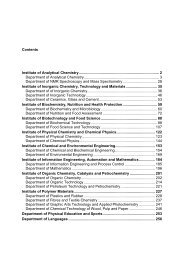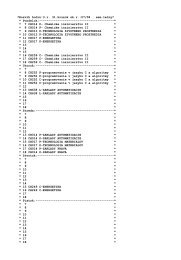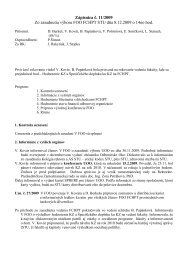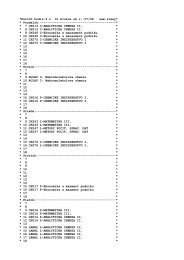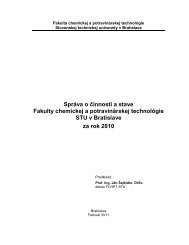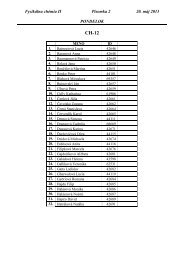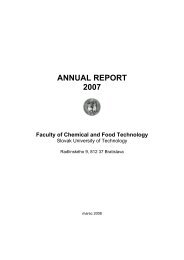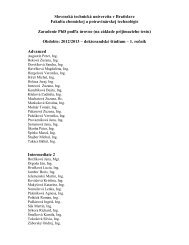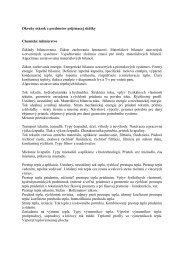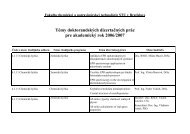rok 2006 - Fakulta chemickej a potravinárskej technológie ...
rok 2006 - Fakulta chemickej a potravinárskej technológie ...
rok 2006 - Fakulta chemickej a potravinárskej technológie ...
You also want an ePaper? Increase the reach of your titles
YUMPU automatically turns print PDFs into web optimized ePapers that Google loves.
supply security. Systematic studies of electrochemical molten salt synthesis are proposed for an effective method<br />
for synthesis of Fe(VI).<br />
The ways to reach the project goals can be summarised as follows :<br />
- to make a thermodynamic topology search of the molten systems suitable for preparation of alkali ferrates<br />
- decreasing of the working electrolyte temperature to the lowest possible value<br />
- to measure an electrochemical characteristic of chosen molten system with a different type of electrodes<br />
material<br />
- electrochemical synthesis of alkali ferrates in the molten system<br />
- investigation of electrode reaction mechanism<br />
- impedance characteristic of the measured systems<br />
- optimalisation of the working parametres as current density, electrode material, melt composition, polarisation<br />
mode (AC/DC)<br />
- study of the properties of boundary layer on working electrode<br />
- SEM investigation of the electrode surface layer<br />
Project duration: from January 2005 to December 2007<br />
APVT Project No APVT-20-000204 Electrochemical Deposition of Lanthanum from Fluoride<br />
Melts (Marta Ambrová)<br />
The spent nuclear fuel treatment is one of the alternatives to the present storage of spent fuel in deep geological<br />
storages. The present used ways are based on the neutron source. The possibility of using of chemical<br />
separation processes is under study, too.No one commercal cycle exists which could be fully satisfactory. The<br />
separation processes in the melts were studying in 50 th years. But they were not implemented because of high<br />
requirements on materials. These processes are realized at the temperature higher than 500 °C and used<br />
chemical agents are very aggressive. It means that there are serious problems at choosing of appropriate<br />
construction materials.<br />
The separation process of lanthanides and actinides is partially handled in chloride melts. However, this<br />
process does not suit the concept of the new types of reactors, where the fluoride melts are considered as carrier<br />
melts. It is important to handle the separation process from fluoride melts. In Czech Republic in Nuclear Research<br />
Centre in Řež, the technology based on the distillation of volatile fluorides was proposed. Uranium species can be<br />
distilled as UF 6 from the spent fuel. Solid fluoridated products and non-fluoridated species remain in the distillation<br />
residue (plutonium, actinides, ...). Electroseparation could be used to separate these species.<br />
New knowledge on the properties of the possible melt systems is needed for electroseparation. At<br />
present, the thermodynamic properties of the pure compounds, a few relevant phase diagrams and some<br />
“standard” (but inconsistent) electrochemical potentials of lanthanides and actinides compounds are available.<br />
Electrodeposition of lanthanum was chosen as a model system. Different methods of the<br />
electrodeposition can be tested in the model system. The main objective is split into the following steps:<br />
- solubility of lanthanum compounds in fluoride melts,<br />
- construction of the high-temperature electrolytic cell with exactly defined conditions,<br />
- electrode materials for electrodeposition with lanthanum depolarisation,<br />
- electrolytic deposition of lanthanum from the appropriate electrolyte,<br />
- influence of the pulse electrolysis.<br />
Project duration: from January 2005 to December 2007<br />
V. CURRENT EDUCATION PROJECTS<br />
VI. COOPERATION<br />
A. Cooperation in Slovakia<br />
Institution<br />
Type of cooperation<br />
Responsible<br />
person<br />
VUJE, Trnava Transmutation of spent nuclear fuel Ing. Petr Dařílek<br />
VUCHT, Bratislava<br />
SHMÚ<br />
Kinetics of limestone dissolution in nitric acid.<br />
Treatment of calcium nitride solution<br />
Balance of green house emissions<br />
Ing. Janka<br />
Szemesova<br />
Duration<br />
January –<br />
December<br />
<strong>2006</strong><br />
March –<br />
December<br />
<strong>2006</strong><br />
May –<br />
November<br />
<strong>2006</strong><br />
39



